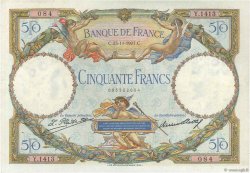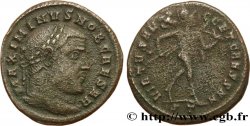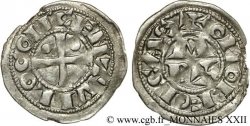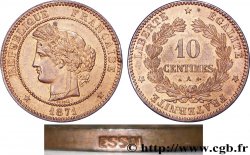v39_1007 - 10 centimes Cérès, “ESSAI” en creux sur la tranche 1871 Paris F.135/6 var.
MONNAIES 39 (2009)
Prezzo di inizio : 200.00 €
Valutazione : 600.00 €
Prezzo realizzato : 696.00 €
Numero di offerte : 12
Offerta maxima : 855.00 €
Prezzo di inizio : 200.00 €
Valutazione : 600.00 €
Prezzo realizzato : 696.00 €
Numero di offerte : 12
Offerta maxima : 855.00 €
Tipo : 10 centimes Cérès, “ESSAI” en creux sur la tranche
Data: 1871
Nome della officina / città: Paris
Quantità coniata : ---
Metallo : bronzo
Diametro : 30,26 mm
Asse di coniazione : 6 h.
Peso : 10,26 g.
Orlo : lisse suivi de ESSAI en creux
Grado di rarità : UNIQUE
Commenti sullo stato di conservazione:
Petit point vert au-dessus de la tête de Cérès. Petit choc sur le listel du droit à 3h à l’emplacement du mot ESSAI. Du brun recouvre les surfaces mais la monnaie conserve une grande partie de son rouge et de son brillant d’origine. Légère patine
N° nelle opere di riferimento :
Diritto
Titolatura diritto : REPUBLIQUE FRANÇAISE // *1871*.
Descrittivo diritto : Tête de la République à gauche en Cérès, déesse des moissons, portant un collier de perles, un double chignon et une couronne composite de blé, fleurs, olivier et olives, chêne et glands, nouée par un ruban descendant sur le cou et passant sur le front où est inscrit le mot CONCOR ; sous la tranche du cou le long du grènetis OUDINÉ, le tout dans un grènetis.
Rovescio
Titolatura rovescio : LIBERTÉ * ÉGALITÉ * FRATERNITÉ *.
Descrittivo rovescio : 10 / CENTIMES, en deux lignes dans le champ, au-dessus de la lettre d'atelier A encadrée des différents, dans une couronne ouverte nouée par un ruban à sa base, formée à gauche d'une branche de laurier, à droite d'une branche d'olivier.
Commento
Le mot ESSAI, et non la lettre E traditionnelle située à l’emplacement de la lettre d’atelier, est inscrit en creux sur la tranche. Manque au Mazard, au Guilloteau et au Gadoury 1989. Notre exemplaire est donc unique et inédit. Il a fait l’objet d’un article dans le Bulletin Numismatique n° 62 page 3. Il possède toutes les caractéristiques de la monnaie de frappe courante : son poids est 10,26 g, son module de 30,26 mm. Le poinçon ayant servi à insculper le mot ESSAI est authentique. Il ne peut donc pas s'agir d'une quelconque bidouille. Cette monnaie soulève un certain nombre d'interrogations : Quels sont les motifs de sa frappe ? Pourquoi avoir placé le mot ESSAI sur la tranche et non sur l'avers ou le revers ? Il faut noter que le mot ESSAI apparaît, pour la première fois, sur les monnaies du type suivant, les 5 et 10 centimes Daniel-Dupuis. Philippe Michalak nous fait remarquer, à ce titre, l’existence d’une épreuve (Essai) de 10 centimes Dupuis, Collection Carles-Jongues, avec le mot "ESSAI" situé sur la tranche qui ressemble fortement à celui de notre exemplaire. S'est-on alors servi de notre 10 centimes 1871 A pour tester le poinçon ESSAI avant de l'appliquer sur une 10 centimes Daniel-Dupuis ? Ceci expliquerait alors le coup sur le listel, qui est postérieur à sa frappe, et ferait de notre exemplaire un prototype préliminaire de 10 centimes Dupuis pour mettre au point le poinçon "ESSAI". Une 5 centimes Cérès avec le double mot ESSAI sur l’avers aurait également servi pour la mise au point de la 5 centimes Dupuis (exemplaire Collection Carles-Jongues).
The word ESSAI, and not the traditional letter E located in the location of the workshop letter, is inscribed in relief on the edge. Missing Mazard, Guilloteau and Gadoury 1989. Our example is therefore unique and unpublished.. It was the subject of an article in the Numismatic Bulletin n° 62 page 3. It has all the characteristics of current minted currency: its weight is 10.26 g, its module is 30.26 mm. The punch used to inscribe the word ESSAI is authentic. So it can't be some kind of hack.. This coin raises a number of questions: What are the reasons for its minting? Why was the word ESSAI placed on the edge and not on the obverse or reverse? It should be noted that the word ESSAI appears, for the first time, on coins of the following type, the 5 and 10 centimes Daniel-Dupuis. Philippe Michalak points out to us, in this regard, the existence of a proof (Essai) of 10 centimes Dupuis, Carles-Jongues Collection, with the word \\\"ESSAI\\\" located on the edge which strongly resembles that of our example. Was our 10 centimes 1871 A then used to test the ESSAI hallmark before applying it to a 10 centimes Daniel-Dupuis? This would then explain the mark on the rim, which is later than its minting, and would make our example a preliminary prototype of 10 centimes Dupuis to develop the \\\"ESSAI\\\" hallmark.. A 5 centime Cérès with the double word ESSAI on the obverse would also have been used for the development of the 5 centime Dupuis (Carles-Jongues Collection example)
The word ESSAI, and not the traditional letter E located in the location of the workshop letter, is inscribed in relief on the edge. Missing Mazard, Guilloteau and Gadoury 1989. Our example is therefore unique and unpublished.. It was the subject of an article in the Numismatic Bulletin n° 62 page 3. It has all the characteristics of current minted currency: its weight is 10.26 g, its module is 30.26 mm. The punch used to inscribe the word ESSAI is authentic. So it can't be some kind of hack.. This coin raises a number of questions: What are the reasons for its minting? Why was the word ESSAI placed on the edge and not on the obverse or reverse? It should be noted that the word ESSAI appears, for the first time, on coins of the following type, the 5 and 10 centimes Daniel-Dupuis. Philippe Michalak points out to us, in this regard, the existence of a proof (Essai) of 10 centimes Dupuis, Carles-Jongues Collection, with the word \\\"ESSAI\\\" located on the edge which strongly resembles that of our example. Was our 10 centimes 1871 A then used to test the ESSAI hallmark before applying it to a 10 centimes Daniel-Dupuis? This would then explain the mark on the rim, which is later than its minting, and would make our example a preliminary prototype of 10 centimes Dupuis to develop the \\\"ESSAI\\\" hallmark.. A 5 centime Cérès with the double word ESSAI on the obverse would also have been used for the development of the 5 centime Dupuis (Carles-Jongues Collection example)








 Segnalare un errore
Segnalare un errore Stampate la pagina
Stampate la pagina Condividi mia selezione
Condividi mia selezione Fai una domanda
Fai una domanda Consegnare / vendere
Consegnare / vendere
 Descrittivo
Descrittivo















